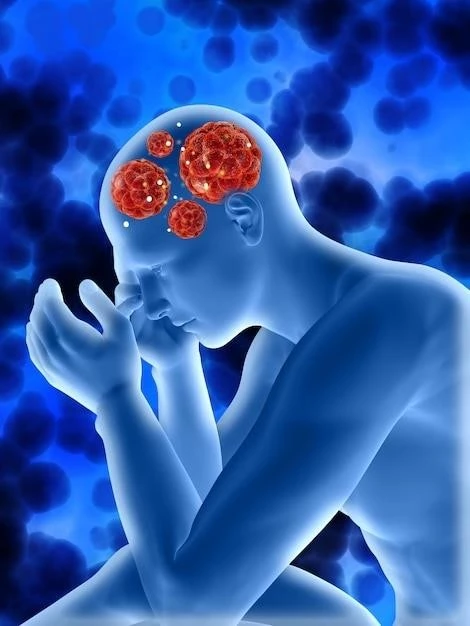Gliosarcoma ⎻ A Rare and Aggressive Brain Tumor
Gliosarcoma is a rare and aggressive brain tumor that presents complex challenges in diagnosis and treatment․ Understanding the key aspects of this malignancy is crucial for healthcare professionals and patients alike․
Overview of Gliosarcoma
Gliosarcoma is a rare and aggressive malignant brain tumor that arises from glial cells․ It is characterized by both gliomatous (glial) and sarcomatous (connective tissue) components‚ making it highly invasive and challenging to treat․
These tumors are more commonly found in adults and are known for their rapid growth and infiltrative nature within the brain․ Gliosarcomas are classified as Grade IV tumors‚ indicating their high degree of malignancy․
The exact cause of gliosarcoma is not fully understood‚ but there are risk factors such as exposure to radiation or underlying genetic conditions that may contribute to its development․ Patients diagnosed with gliosarcoma often experience symptoms related to increased intracranial pressure‚ seizures‚ and neurologic deficits․
Due to its aggressive nature‚ gliosarcoma prognosis is generally poor‚ with a limited median survival even with aggressive treatment approaches․ Treatment usually involves a combination of surgery‚ chemotherapy‚ and radiation therapy‚ aiming to alleviate symptoms‚ reduce tumor size‚ and prolong survival․
Research into innovative treatment modalities and understanding the underlying molecular mechanisms of gliosarcoma continues to evolve‚ providing hope for improved outcomes in the future․ Close monitoring by oncologists‚ neurosurgeons‚ and other healthcare providers is essential to address the complex needs of patients with gliosarcoma․
Causes and Risk Factors
The exact causes of gliosarcoma are not definitively known‚ but certain risk factors have been identified that may contribute to the development of this aggressive brain tumor․ Exposure to ionizing radiation‚ either from previous radiation therapy or environmental factors‚ is considered a significant risk factor for gliosarcoma․
Additionally‚ individuals with certain genetic conditions such as neurofibromatosis type 1 (NF1) or Li-Fraumeni syndrome may have an increased predisposition to developing gliosarcoma․ These genetic mutations can affect the normal regulatory pathways of cell growth and division‚ potentially leading to the formation of tumors in the brain․
Age is also a factor‚ as gliosarcoma is more commonly diagnosed in adults than in children․ The incidence of gliosarcoma tends to increase with age‚ with a higher prevalence observed in older individuals․ While the exact interplay of genetic predisposition‚ environmental factors‚ and age in the development of gliosarcoma is complex and multifactorial‚ ongoing research aims to elucidate the underlying mechanisms of tumor initiation and progression․
Understanding the causes and risk factors associated with gliosarcoma is crucial for early detection‚ intervention‚ and personalized treatment strategies․ By identifying individuals who may be at higher risk for developing gliosarcoma‚ healthcare providers can implement proactive monitoring and surveillance measures to improve outcomes and quality of life for patients at risk for this rare and aggressive brain tumor․
Diagnosis and Prognosis
Diagnosing gliosarcoma requires a comprehensive approach that typically involves imaging studies such as MRI or CT scans to visualize the brain tumor and assess its characteristics․ A definitive diagnosis often necessitates a surgical procedure to obtain a tissue sample for histopathological analysis․
Neurosurgeons perform biopsies or surgical resections to confirm the presence of gliosarcoma‚ which is crucial for determining the appropriate treatment strategy․ The examination of tumor markers and genetic mutations in the tumor cells can provide further insights into the prognosis and potential targeted therapies․
Gliosarcoma has a challenging prognosis due to its aggressive nature and tendency to recur despite treatment․ The overall survival rate for patients with gliosarcoma is often limited‚ with factors such as the extent of surgical resection‚ age of the patient‚ and response to adjuvant therapies influencing the prognosis․
While advancements in surgical techniques‚ chemotherapy agents‚ and radiation therapy have improved outcomes for some individuals with gliosarcoma‚ the overall prognosis remains guarded․ Regular follow-up evaluations by oncologists and neurosurgeons are essential to monitor disease progression‚ assess treatment response‚ and provide supportive care to optimize quality of life for patients living with gliosarcoma․

Treatment Options
The management of gliosarcoma involves a multidisciplinary approach focusing on surgery‚ chemotherapy‚ and radiation therapy․ Surgical resection‚ performed by neurosurgeons‚ aims to remove as much of the tumor mass as safely possible to alleviate symptoms and improve outcomes․
After surgery‚ adjuvant therapies such as chemotherapy and radiation therapy are commonly employed to target any remaining cancerous cells and reduce the risk of tumor recurrence․ Chemotherapy drugs‚ including temozolomide and other agents‚ may be prescribed to inhibit the growth of gliosarcoma cells․
Radiation therapy‚ often administered by radiation oncologists‚ uses high-energy X-rays to target and destroy cancer cells․ This treatment modality may be recommended postoperatively to target residual tumor tissue and prevent its regrowth in the brain․
For recurrent or refractory gliosarcoma cases‚ additional treatment options such as targeted therapy‚ immunotherapy‚ or participation in clinical trials may be considered․ Targeted therapies aim to disrupt specific molecular pathways that drive tumor growth‚ while immunotherapy harnesses the body’s immune system to target and attack cancer cells․
Exploring innovative treatment approaches and participating in research studies can offer hope for patients with gliosarcoma‚ as new therapeutic strategies continue to be developed and refined․ Ongoing collaboration between oncologists‚ neurosurgeons‚ and other healthcare providers is crucial to tailor treatment plans to the individual needs of patients and optimize outcomes in the management of this aggressive brain tumor․
Current Research and Advances
Ongoing research into gliosarcoma aims to uncover novel treatment strategies and advancements to improve patient outcomes and quality of life․ Scientists are investigating the molecular mechanisms underlying gliosarcoma development‚ progression‚ and resistance to conventional therapies․
Advances in genomic profiling and tumor marker analysis have enabled a better understanding of the genetic alterations and signaling pathways driving gliosarcoma growth․ This knowledge is crucial for developing targeted therapies that specifically inhibit these pathways and enhance treatment efficacy․
Clinical trials evaluating new chemotherapy agents‚ immunotherapies‚ and combination treatment approaches are underway to assess their effectiveness in managing gliosarcoma․ These trials offer patients access to cutting-edge interventions that have the potential to revolutionize the standard of care for this aggressive brain tumor․
Radiation therapy techniques‚ such as stereotactic radiosurgery and proton therapy‚ continue to evolve‚ allowing for more precise and tailored delivery of radiation to gliosarcoma lesions while sparing surrounding healthy brain tissue․ These advancements aim to enhance treatment outcomes and reduce treatment-related side effects․
Furthermore‚ collaborative research efforts between academic institutions‚ pharmaceutical companies‚ and healthcare providers are essential for accelerating progress in the field of gliosarcoma treatment․ By sharing knowledge‚ resources‚ and expertise‚ the scientific community strives to bridge gaps in understanding and develop innovative therapies that offer hope to patients affected by this rare and aggressive brain tumor․
Support and Care for Patients
Support and care for patients with gliosarcoma are multifaceted and encompass physical‚ emotional‚ and logistical aspects․ A multidisciplinary team consisting of oncologists‚ neurosurgeons‚ nurses‚ social workers‚ and counselors collaborates to provide comprehensive support throughout the treatment journey․
Patients diagnosed with gliosarcoma and their families may benefit from access to support groups‚ counseling services‚ and educational resources that help navigate the challenges associated with the disease․ These resources offer emotional support‚ guidance on treatment options‚ and practical tips for managing symptoms and side effects․
Palliative care specialists play a vital role in addressing pain management‚ symptom control‚ and improving quality of life for patients with advanced gliosarcoma․ Their focus is on enhancing comfort‚ dignity‚ and holistic well-being while respecting patients’ preferences and goals of care․
Care coordination between healthcare providers‚ home health services‚ and community organizations is essential for ensuring continuity of care and seamless transitions between different stages of treatment․ This collaborative approach aims to optimize patient outcomes and enhance the overall patient experience․
Educating patients and their caregivers about the importance of adherence to treatment plans‚ monitoring for signs of disease progression‚ and seeking timely medical attention is paramount in empowering individuals facing gliosarcoma․ Through a combination of medical expertise‚ emotional support‚ and practical assistance‚ healthcare teams strive to promote resilience and improve the overall quality of life for patients living with this rare and challenging brain tumor․
